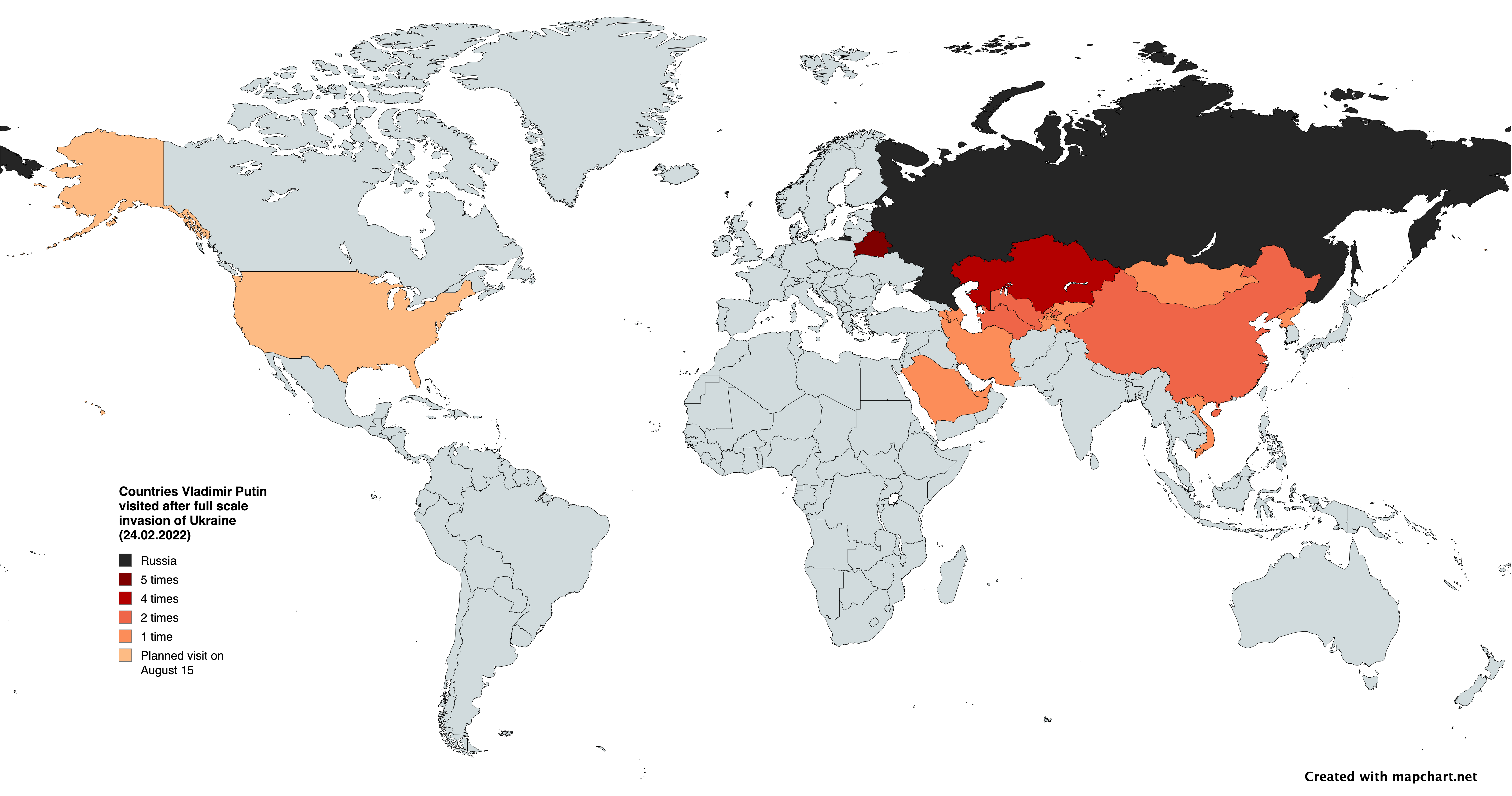Map of Countries Vladimir Putin Visited Post-Invasion of Ukraine


David Chen
Data Visualization Specialist
David Chen is an expert in transforming complex geographic datasets into compelling visual narratives. He combines his background in computer science ...
Geographic Analysis
What This Map Shows
This map provides a clear visualization of the countries that Russian President Vladimir Putin visited following the full-scale invasion of Ukraine in February 2022. It highlights a range of diplomatic engagements, illustrating not just the geographical footprint of Russia's interactions but also the political dynamics at play in different regions of the world. By examining the destinations selected by Putin during this time, we can gain insights into Russia's foreign relationships and the geopolitical landscape that has emerged since the invasion.
Deep Dive into Diplomatic Engagements
The countries visited by Putin post-invasion present a fascinating tableau of Russia's diplomatic strategy and its quest for support amid international isolation. In the wake of the invasion, many Western nations imposed severe sanctions on Russia, leading to a significant shift in its foreign policy focus. Interestingly, rather than retreating into isolation, Putin actively sought stronger ties with countries that have historically been more sympathetic, or at least neutral, towards Russia.
One of the most notable regions of engagement for Putin has been the Middle East. Countries like Iran and Turkey have become pivotal allies. For instance, in July 2022, Putin met with Iranian President Ebrahim Raisi and Turkish President Recep Tayyip Erdoğan in Tehran. This meeting was significant, as it not only solidified Russia's ties with these nations but also highlighted their shared interests in the Syrian conflict and energy markets.
Moreover, Putin's visits to Central Asian nations, such as Kazakhstan and Uzbekistan, underscore Russia's efforts to maintain influence in its traditional sphere of influence. The Collective Security Treaty Organization (CSTO), which includes several of these countries, has been a cornerstone of Russia's security strategy in the region. The focus here is on reasserting control and ensuring that these nations do not drift towards Western alliances, particularly in the context of rising tensions with NATO.
Additionally, interactions with nations in Africa, such as Egypt and South Africa, reveal Russia's attempts to cultivate relationships where Western influence is less dominant. Russia's growing presence in Africa, particularly through military contracts and arms sales, is an important part of its strategy to counterbalance Western sanctions.
Regional Analysis
Breaking down the regions shown on the map highlights diverse geopolitical dynamics. In Europe, Putin's visits have been sparse due to the overwhelming condemnation of the invasion from most European nations. However, his efforts to maintain ties with countries like Hungary, which has shown a more lenient stance towards Russia, indicate that he is still trying to exploit divisions within the European Union.
In contrast, the Middle East remains a hotspot for Russian diplomatic activity. The partnerships formed here are often based on mutual interests—energy production, military cooperation, and countering U.S. influence. For example, Russia's role in brokering deals in the Syrian conflict has positioned it as a key player in the region, making it appealing for Middle Eastern nations to engage with Putin.
Central Asia presents a unique landscape where Russia retains considerable influence. Countries like Kyrgyzstan and Tajikistan are heavily reliant on Russia for economic support and security, which gives Putin leverage in these discussions. However, these nations also have to navigate their relationships with China, which has been increasing its footprint in the region.
In Africa, the relationships are often transactional, focusing on arms deals and military support. Russia’s growing engagement in Africa is particularly significant, as many countries are seeking alternatives to Western aid and influence. This dynamic reflects a broader trend of countries reassessing their alliances in a multipolar world.
Significance and Impact
The topic of Putin's diplomatic travels post-invasion is not just about the locations he has visited; it speaks volumes about the shifting global order and the realignment of international alliances. These visits indicate a strategic pivot, where Russia is seeking to reinforce its relationships with nations that are either sympathetic to its cause or willing to offer economic and political support amid Western sanctions.
The significance of these engagements cannot be understated. For instance, as Russia continues to strengthen ties with countries in the Global South, it may find new avenues to circumvent sanctions and bolster its economy. Furthermore, the diplomatic efforts in regions like the Middle East and Africa could reshape power dynamics, leading to a more fragmented international response to conflicts.
Looking ahead, the implications of Putin's travels are profound. As countries respond to the geopolitical shifts initiated by Russia's actions in Ukraine, the global landscape may evolve into one characterized by greater competition for influence among major powers. This emerging multipolarity could lead to heightened tensions and a reevaluation of traditional alliances, which makes understanding the motivations behind Putin's visits crucial for analysts and policymakers alike.
Ultimately, the map of countries visited by Putin serves as a reminder of the complexities of international relations and the ongoing challenges posed by the current geopolitical climate.
Visualization Details
- Published
- August 9, 2025
- Views
- 154
Comments
Loading comments...